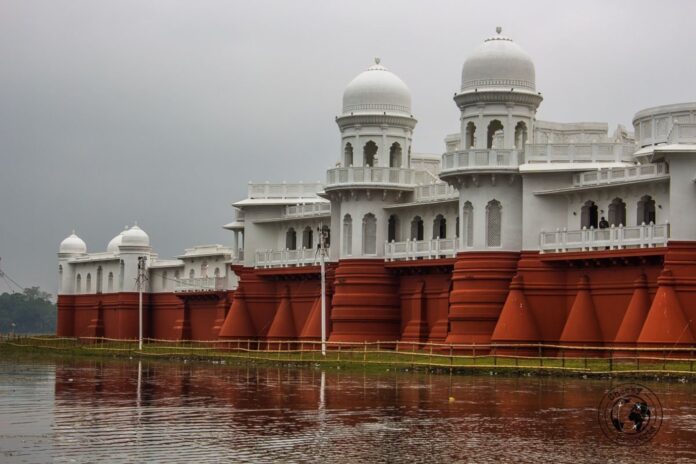Neermahal, meaning “Water Palace” in the local language, stands as a captivating architectural gem amidst the tranquil waters of Rudrasagar Lake in Tripura. This magnificent palace is a testament to the grandeur and rich history of the region. In this article, we delve into the intricate details of Neermahal, exploring its fascinating history, architectural features, and the significance it holds in Tripura’s cultural heritage.
Historical Background: Neermahal was constructed in the early 20th century by Maharaja Bir Bikram Kishore Debbarman Manikya, one of the prominent rulers of the erstwhile Tripura Kingdom. The palace served as a summer retreat for the royal family and hosted extravagant festivities, attracting nobles and dignitaries from far and wide.
Architectural Marvel: The architectural style of Neermahal combines elements of both Hindu and Islamic designs, creating a unique synthesis. The palace stands on a raised platform and features two distinct sections: the royal residence known as Andar Mahal and the public hall called Rangmahal.
Andar Mahal: The Andar Mahal, or the inner palace, was exclusively used by the royal family. It showcases intricate carvings, exquisite wall paintings, and ornate pillars that reflect the opulence of the bygone era. The spacious rooms, adorned with delicate motifs and traditional artwork, still evoke a sense of regality.
Rangmahal: The Rangmahal, the public hall of the palace, served as a venue for cultural performances, feasts, and social gatherings. It boasts a grand hall with a seating capacity for hundreds of guests. The expansive balconies provide panoramic views of the lake, adding to the enchanting ambiance.
Strategic Location and Engineering Marvel: The location of Neermahal on the Rudrasagar Lake is not merely aesthetic but also serves practical purposes. The lake acts as a natural moat, offering protection to the palace. Moreover, it acts as a reservoir, ensuring a steady supply of water for the surrounding regions.
The architectural brilliance of Neermahal lies in its foundation that allows it to withstand the changing water levels of the lake. The palace is constructed using special techniques that enable it to remain submerged during the monsoon season and emerge when the water recedes, creating a visual spectacle.
Cultural Significance and Tourism: Neermahal holds immense cultural significance in Tripura. It serves as a reminder of the state’s royal heritage and architectural prowess. Today, it is a popular tourist attraction, drawing visitors from far and wide to witness its splendor and experience the serene beauty of Rudrasagar Lake.
The Tripura Tourism Development Corporation (TTDC) has taken initiatives to promote Neermahal as a major tourist destination. Visitors can explore the palace, admire the intricate craftsmanship, and enjoy boat rides on the lake, immersing themselves in the tranquil surroundings.
Preservation and Future Prospects: Efforts have been made to preserve Neermahal and restore its original glory. The palace has undergone renovation and conservation projects to ensure its structural integrity. The government, along with heritage organizations, is actively involved in maintaining this architectural marvel for future generations to appreciate and admire.
Conclusion: Neermahal, with its awe-inspiring architecture and scenic location, stands as a proud symbol of Tripura’s cultural heritage. Its historical significance, engineering marvel, and cultural value make it a must-visit destination for travelers seeking a glimpse into the regal past of Tripura. As the palace continues to captivate visitors with its charm, Neermahal remains an enduring testimony to the rich legacy of the region.




